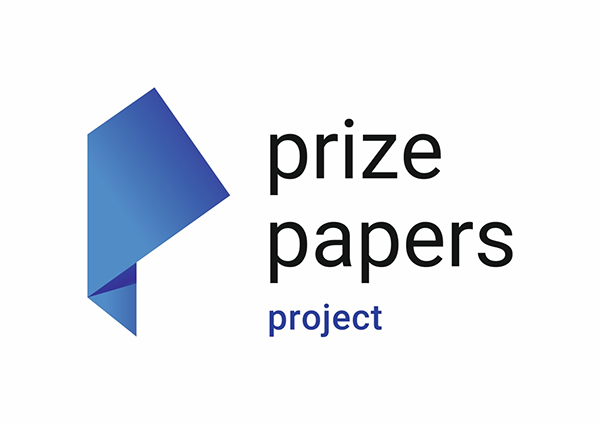
The Prize Papers Project, a long-term Anglo-German project in which The National Archives is a partner, has just launched the first of many sets of digitised Prize Papers, with many more to be rolled out over the next 15 years.[ref]The Prize Papers Project is based at the Carl von Ossietzky University of Oldenburg, Germany, and The National Archives in London, UK. The project is part of the Göttingen Academy of Sciences and Humanities, Germany and co-operates closely with the German Historical Institute London (GHIL), as well as the VZG (the headquarters of the Common Library Network) in Göttingen, who provide their IT expertise. As of 2018, the Prize Papers Project has been part of the Academies Programme of the Union of the German Academies of Sciences and Humanities. Thus, it is funded by the German state and the federal state of Lower Saxony, with a prospective funding period from 2018 to 2037.[/ref]
In the days when wooden ships could be taken by (threat of) force, without necessarily sinking, the capture of enemy or neutral ships and their cargoes as ‘prize’ was a standard part of warfare, to disrupt enemy trade; neutral ships were captured if they were suspected of carrying enemy goods.
During the French Revolutionary/Napoleonic Wars, and the War of 1812, the British alone captured more than 25,000 ships across the world. The High Court of Admiralty in London or the many British Vice-Admiralty courts in the Caribbean, the Atlantic, the Mediterranean, and the Indian Ocean judged the legality of the captures.
Just over 3,000 appeals from the judgments of these lower courts were submitted by neutrals (NOT enemies), or by disgruntled British captors, to the Lords Commissioners in Prize Appeals, in Downing Street, in these wars. About half the litigants printed their arguments and evidence, for the convenience of the Appeal Court: these 1,593 printed appeals are now available online. They contain detailed evidence, in English, about:
- the slave trade from Africa
- trade across the world, with neutrals taking over ‘enemy’ trades
- letters sent by ship, about family life and business
- the British captors, both Royal Navy and privateers
These appeals come from 55 volumes of printed Prize Appeals (HCA 45) 1793-1815 – the Appeal Court’s own bound set of 1,593 printed appeals, with manuscript judgments added. These were initially catalogued by volunteers working with a member of the Oldenburg Prize Papers team, at The National Archives.
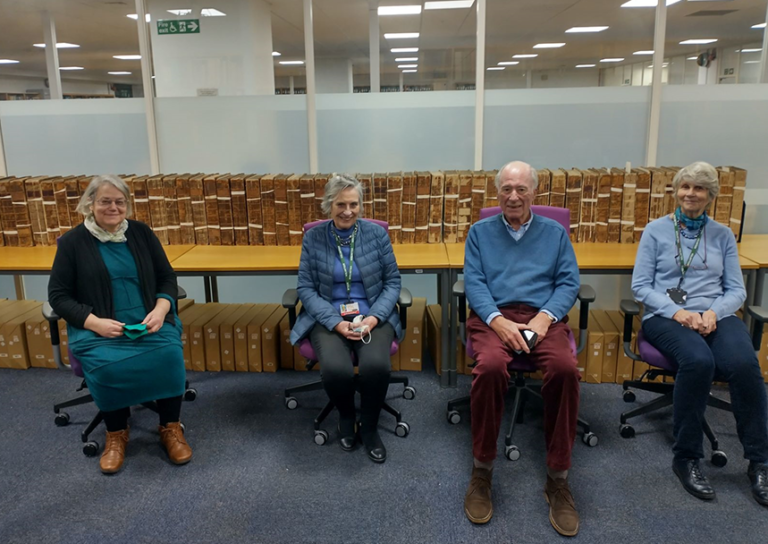
What is in a printed appeal?
First, each side presented its own narrative of voyages, cargoes and capture, with details of the trial in the lower court. The examinations of the captured crews, and transcriptions (in English translation) of the relevant ship’s papers and letters found on board the ship, were printed in an appendix as evidence of national status.
There was a considerable time-lag between capture, decree in the original court, and a decree in appeal. Four years from capture was quite usual – some cases lasted a decade. Delays were inevitable when relevant papers were held in various parts of the world.
Who appealed, and from where?
The majority are about American ships, with neutral northern Europeans coming in next (Denmark, Sweden, and German states – Prussia, Hamburg, Bremen, Danzig, Lubeck, Oldenburg etc). British captors also appealed over disputed joint-captures.
Two-thirds of the printed appeals are from judgments made in the 14 Caribbean Vice-Admiralty courts, Newfoundland and Nova Scotia. Appeals from the London High Court of Admiralty and the Mediterranean Vice-Admiralty courts (Malta, Minorca and Gibraltar) amount to a further 469. Forty-five appeals come from the Vice-Admiralty Courts of Bombay, Calcutta, Madras, Ceylon and the Cape of Good Hope, from ships traversing the southern hemisphere in the course of trade with China, Japan, Indonesia, India and Mauritius. Thirteen come from Sierra Leone, which dealt mostly with slave-trade captures.
Slave-trader appeals
There are roughly 70 appeals about the capture of ships involved in the trade in enslaved people from Africa to the Americas, the Caribbean, and Mauritius, both before and after 1807 (which saw British and US acts against the slave trade). The slave trade appeals give close-up evidence of the trade in human beings, and of the ingrained inhumanity of the traders. They include appeals from several nations (although, by the very nature of the source, British slave-traders are not well-represented).
- 24 American appeals: see e.g. the ‘Polly’, John Widdefield (master), from the Vice-Admiralty Court of Jamaica, 1804 – which had on board 144 enslaved people from the Rio Pongo, (Guinea), and 44 tusks of ivory, to be sold at Havana, Cuba.
- 19 Portuguese and Spanish appeals: see e.g. the ‘Sao Joaquim’, Vincente Thomas Dos Santos (master), from the Vice-Admiralty Court of the Cape of Good Hope, 1817 – a voyage taking 340 enslaved people from Mozambique to Brazil in 1815; and the ‘Gertrudis La Preciosa’, Jose Torne (master), from the Vice-Admiralty Court of Sierra Leone, 1816 , bound from Old Calabar, (Nigeria), to Havana, Cuba in 1814, with about 477 enslaved people on board. These were 255 men, 123 boys, 40 women and 62 girls: not quite as indicated in the owner’s instructions to buy 500 ‘head’, as if people were cattle.

- 6 Danish appeals (small trades within the Caribbean): see the ‘Flying Fish’, Joseph Treguglia (master), from the Vice-Admiralty Court of the Bahamas, 1803, where the master was from Gibraltar.
- 5 French appeals: see a British anti-slave trade capture in September 1815 of the ‘Belle de Bordeaux’, Francois Brian (master), from the Vice-Admiralty Court of Antigua, 1817, bound from Angola to Guadeloupe, carrying 513 enslaved people.
- 1 British appeal: see the ‘Reimsdyke’, James McIver (master), from the Vice-Admiralty Court of Antigua, 1807 – a ship under a Dutch flag, but owned by Thomas King, bound from Guinea to Demerara, with 400 enslaved people on board.
One appeal involved the enslaved rising up and seizing the ship: see the ‘Amelia’, previously the ‘Billy’, Alexander Campbell (master), from the Vice-Admiralty Court of Sierra Leone, 1817. This rising ended tragically – John Roach of Liverpool, hunting slaving ships, found that although the Angolans on board had seized the Billy at sea, and were returning from mid-Atlantic to Africa, they had run out of food after five months at sea. Many had died of starvation.
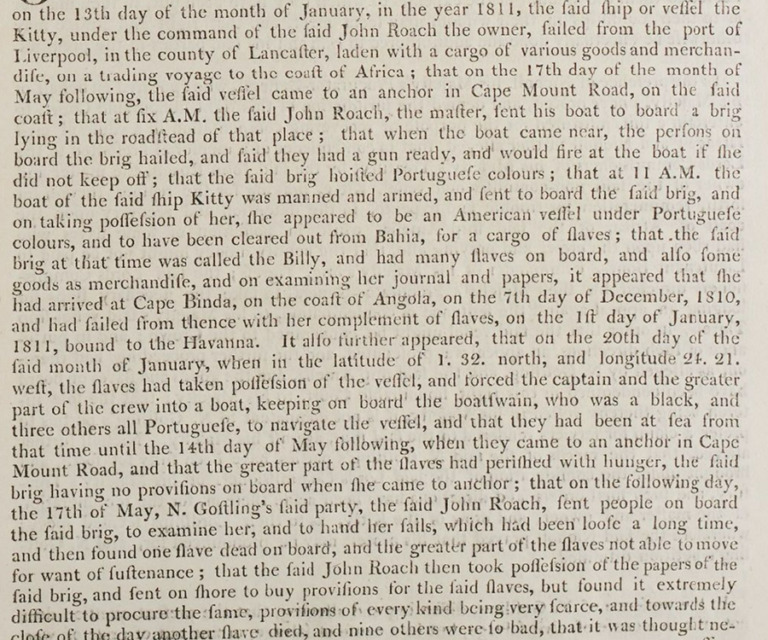
Neutral traders
As warfare spread across Europe, American and North European traders took over what had been French, Spanish and Dutch trades. The most traded commodities were:
- Sugar (450), coffee (443) from European slave colonies in the West and East Indies
- Wine (242), brandy (143) from Europe
- Foodstuffs – flour, corn, wheat, fish, cheese, butter, salt, beef, pork, peas etc
- ‘Warlike stores’ – wood, iron, copper, hemp, sailcloth, pitch, tar, guns and powder
- Dyestuffs – indigo, logwood, dyewood – perhaps for uniforms?
However, unusual commodities can also be found, specified in bills of lading. These paintings were sent from New York to Cuba in 1798, on the ‘Hope’, Samuel Herbert (master).
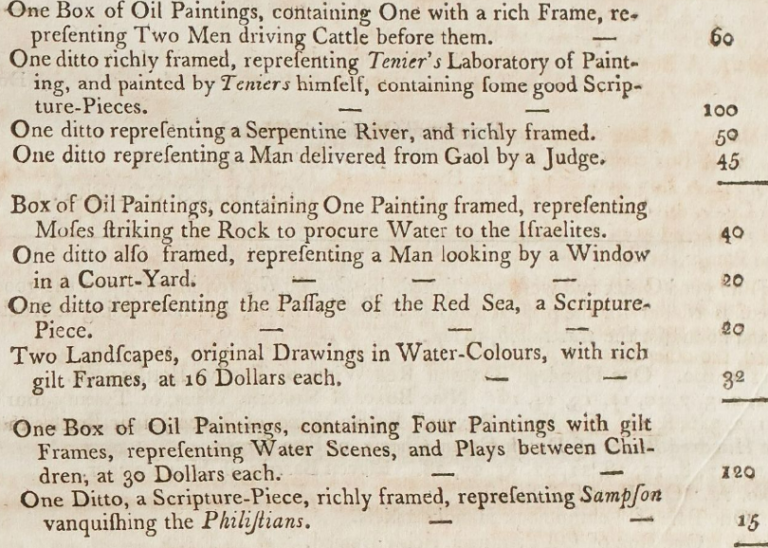
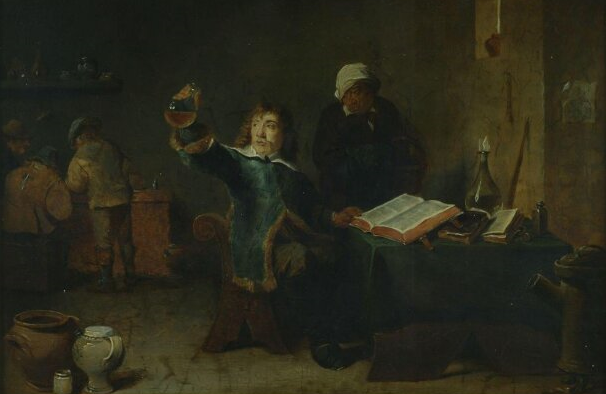
Appeals about American, Caribbean and European trade are the most common, and the commodities covered are more common too:
- An American ship, bound from Beverly, Massachusetts via Alicante, Spain to Livorno, Italy, laden with cod fish and sugar: the ‘Amazon’, Josiah Page (master), from the Vice-Admiralty Court of Malta, 1810. One of the owners of the cargo was Israel Thorndike of Beverly, who had himself made a fortune in prize-taking, and later became an important industrialist.
- A Swedish ship, bound from Barcelona, Spain to Charleston, South Carolina, laden with wine, brandy, almonds, nuts, soap, silk handkerchiefs: the ‘Charlotte’, Swen Konigsen (master), from the Vice-Admiralty Court of Gibraltar, 1804.
Several American appeals were based on having a British pass, often to supply food for the Duke of Wellington’s forces in Spain: see the ‘Reward’, Amos Hill (master), from the Vice-Admiralty Court of Nova Scotia, 1814.
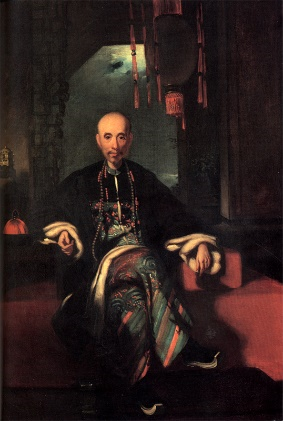
Americans were joining Europeans in trading in China, Japan and the East Indies – and Chinese merchants were getting involved. There are two appeals by the Chinese merchant Howqua of Canton, exporting tea to Boston in 1813, and to Nantucket in 1814: see the ‘Hunter’, William M Rogers (master), from the High Court of Admiralty, 1817 and the ‘Rose’, Rowland Gardner (master), from the Vice-Admiralty Court of the Cape of Good Hope, 1816.
For similar European trades with the East, see the Emden ship ‘Henriette’ or ‘Henrietta’, Godtlieb Jager (master), from the High Court of Admiralty, 1805; or the Bremen ship ‘Triton’, Gottfried Melm (master), from the Vice-Admiralty Court of Jamaica, 1803.
A shadier venture was a cross-Pacific voyage by the American ship ‘Topaz’, William Nicholl (master), at the Vice-Admiralty Court of Bombay, 1811, taken as a suspected pirate in Macao harbour.
Letters sent across the world
Many ships carried mail, and the appeals often print these. Letters were used by captors to provide evidence of enemy affiliation, and as such were collected on capture, numbered as an audit, and inspected by the courts. Many original letters survive in the Prize Papers of the High Court of Admiralty (series HCA 30 and HCA 32), and the next digitisation will include several thousand letters from the 1740s.
The Danish ship Faedrelandet carried letters from Dutch Batavia (Java, Indonesia) to Copenhagen, despite the prohibition on doing so by her Danish owners. This one, No 36 of those on the ship, is from C L Wieling, a Dutch administrator, to his brother Willem in Amsterdam, and is worth reading. He unsuccessfully tried to disguise the letter’s ‘Dutch character’ by putting it inside an outer envelope, addressed to their mother in Hamburg.
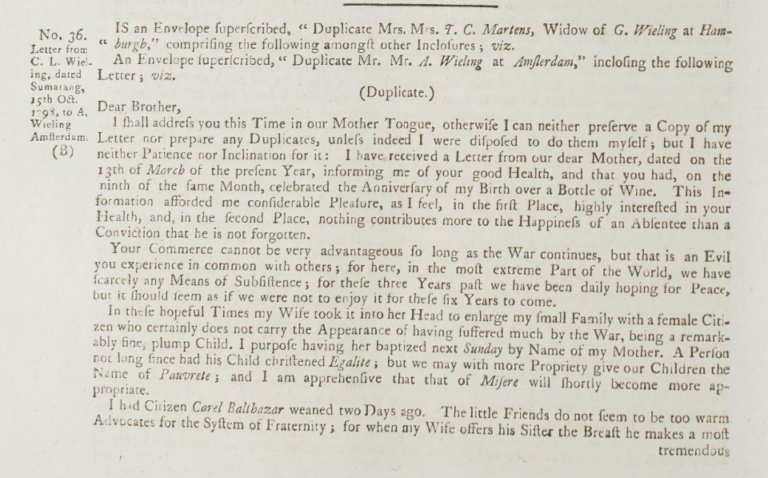
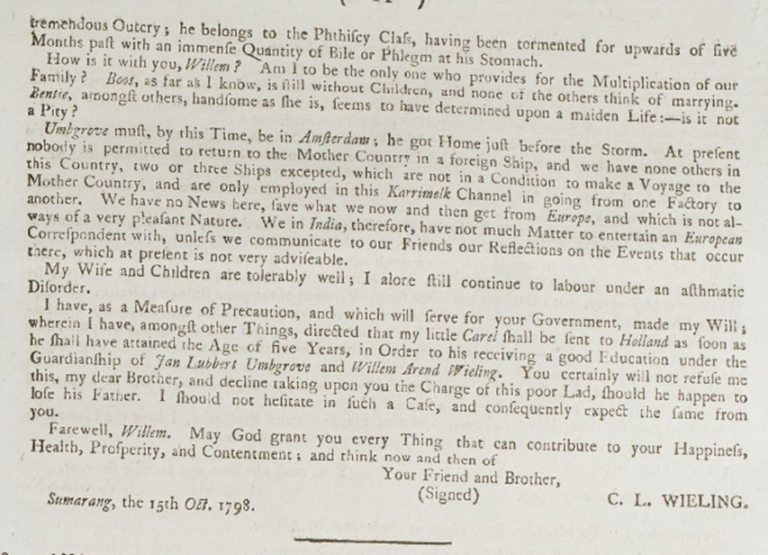
Charles Gobert, a merchant of New York, saw himself as a man of ‘an unbounded ambition … and perhaps a little more capacity than the common run of men’:
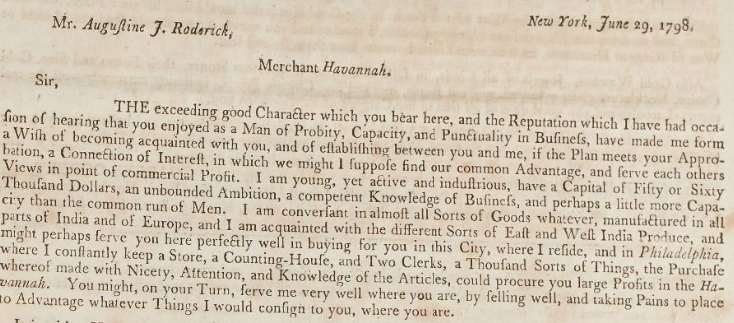
He was perhaps not wholly trustworthy – see his instructions on selling perishable goods in Cuba:

It was Gobert who was exporting the paintings listed above: alas, the capture of the ‘Hope’, Samuel Herbert (master) wrecked his ambitions.
The British captors
Prize-taking was an essential part of warfare. The printed appeals provide information about the myriad of small-scale actions undertaken by the Royal Navy and British privateers, which are very much less well-known than the pitched battles.
The British captors named in appeals are twice more likely to be Royal Navy ships than privateers. Naval captors range from the smallest vessels (such as the tender Minerva which took the ‘Anna Maria’, Esper Hillebrandt (master), 1799 and discovered evidence of treason, up to the taking of a French warship by a squadron under Lord Nelson (the ‘Genereux’, Ciprien Raynauden (master), from the Vice-Admiralty Court of Minorca, 1803).
There are also prize disputes over the capture of territory (or goods there) by British joint forces: see Prize appeal case for ‘Banda Neira and its dependencies’ from the Vice-Admiralty Court of Madras,1813, which describes the growing of mace and nutmeg on slave-manned spice parks at Banda Neira – it was this capture that broke the 200-year Dutch monopoly on nutmegs. Other places subject to prize appeals include the Cape of Good Hope, Naples, Buenos Aires and Moose Island, Maine.
Privateers were very active in the Caribbean, snapping up trade along the American seaboard and to and from the islands. But they too obeyed the rules on seizing and numbering all the papers on any captured ship, as did the Roebuck, on capturing the ‘Betsey’, James Stewart (master), appealed from the Vice-Admiralty Court of Montserrat, 1803.
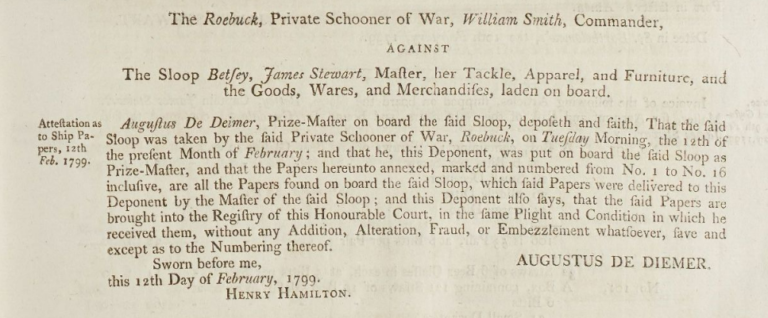
Another way in
These captures can also be investigated in The National Archives’ catalogue Discovery, by searching for ship, master, nationality, voyage, cargo, captor, court etc from the page High Court of Appeals for Prizes: Case Books (Printed Appeal Papers). The results will in future link direct to the Prize Papers Portal, but currently typing a TNA reference with quotation marks (such as “HCA 42/50/2”) into www.prizepapers.de will take you to the digital images of that appeal.
Interesting how an already large Navy could further augment it’s resources with privateers –something like STUFT [Ships Taken Up From Trade} during the 1982 Falklands campaign.